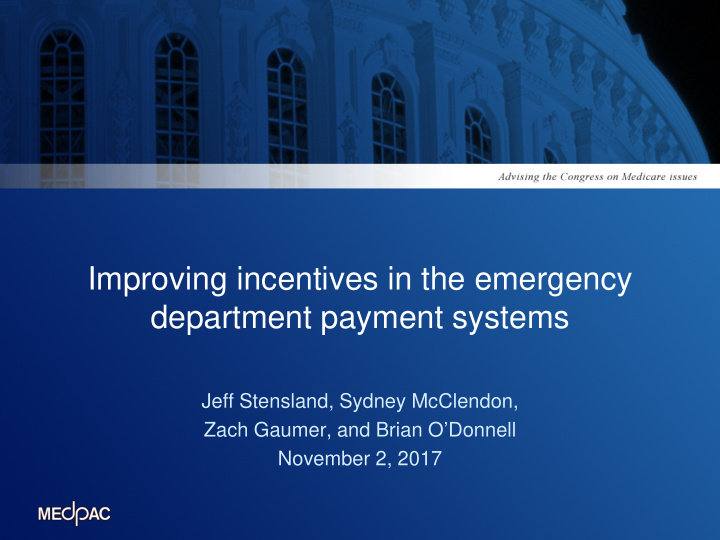



Improving incentives in the emergency department payment systems Jeff Stensland, Sydney McClendon, Zach Gaumer, and Brian O’Donnell November 2, 2017
Outline of today’s presentation Review the emergency department (ED) payment system Background on stand-alone EDs Urban stand-alone ED growth Site neutral (Section 603) concerns Payment concerns Rural ED access concerns Policy options to address concerns 2
Medicare payment for ED and urgent care center services (2017) $300 $264 Hospital outpatient prospective payment system rate Physician fee schedule payment rate $250 $63 $188 $200 $63 $150 $109 $201 $100 $125 $109 $50 $0 Type A hospital ED (open 24/7) Type B hospital emergency Urgent care center/retail department (open less than 24/7) clinic/physician office Note: The physician fee schedule (PFS) payment rates for services delivered in hospital EDs reflect level 3 physician ED services, and payment rates for services delivered in urgent care centers and physician offices reflect level 3 evaluation and management codes for new patients. 3
Stand-alone EDs Two types of stand-alone EDs: Hospital-owned off-campus EDs (OCEDs) Independent freestanding emergency centers 580 stand-alone EDs in operation Only OCEDs can bill Medicare ( if deemed off-campus provider-based departments ) 4
Illustrative example of Medicare ED payments by facility type and geography 35 miles $109 35 miles 35 miles $264 $264 On-campus hospital ED $109 Off-campus hospital ED $109 35 miles Urgent care center Note: The ED payment amounts displayed are for level 3 Type A ED 5 visits and for level 3 office visits at an urgent care center.
Concerns about urban stand-alone EDs The number of stand-alone EDs is growing rapidly in several urban markets Tend to locate in high-income areas Patient severity falls between on-campus hospital EDs and urgent care center (e.g., TX, MD, CO) Lower standby costs than on-campus hospital EDs Equal payment to on-campus hospital EDs 6
Additional incentive to build OCEDs Section 603 of the Bipartisan Budget Act of 2015 exempted emergency departments from off-campus site-neutrality payment rates OCEDs can bill higher OPPS rates for emergency services AND non-emergency services (e.g., physician office visits, imaging) Creates incentives for health systems to co- locate off-campus physician offices within OCEDs 7
Section 603 policy option Current law: OCEDs receive facility fees for scheduled physician office visits Policy option: Pay physician offices co- located with OCEDs the same rates as off- campus physician offices Impacts of the policy: Lower rates for OCED physician practices Lower cost-sharing for beneficiaries Less incentive to build unnecessary OCEDs 8
Urban policy option: Type B rates Resource needs of OCED patients between those of urgent care centers and hospitals’ on-campus EDs More ambulance transports to on-campus ED More walk-ins at OCEDs Set payments to reflect the difference Type B rates if urban OCED within 20 minutes of an on-campus ED Type A rates for more isolated OCEDs 9
Effect of Type B rates for off-campus emergency departments Moderately lower Medicare rates for OCEDs (e.g., reduce from $264 to $188) Moderately lower cost-sharing for beneficiaries Reduced incentive to build EDs when urgent care centers could meet patient needs 10
Background on rural hospital payment policy Long-standing objective: preserve access Current strategy Higher inpatient rates for rural PPS hospitals Cost-based payment for Critical Access Hospitals (CAHs) Two problems Increasingly inefficient Does not always preserve the hospital 11
Declining admissions at Critical Access Hospitals 1000 Total annual discharges per CAH 900 800 700 624 600 500 365 400 300 170 200 81 100 0 2003 2005 2007 2009 2011 2013 2015 Median CAH 10th percentile Source: All-payer discharges reported by hospitals on Medicare cost reports Preliminary results subject to change 12
Cost-based payments do not always preserve access to emergency care 21 critical access hospitals closed from 2013 to 2017 (2 were more than 35 miles from another hospital) CAHs closed despite receiving a median of $500,000 in higher payments for inpatient and post-acute care Would emergency services have been financially viable if Medicare had redirected the supplementary dollars from inpatient to the ED? 13
Rural policy option: 24/7 emergency department in outpatient-only hospital Target isolated hospitals (e.g., 35 miles from other hospitals) Payment Type A outpatient PPS rates per service Fixed amount to help fund standby costs Medicare provides a fixed amount Local entities could be required to provide matching funds 14
Objectives of rural outpatient-only policy option Maintain emergency access in isolated areas Offset the cost of the additional ED payments with efficiency gains from consolidating inpatient services Shift acute patients from low-occupancy to higher-occupancy facilities Shift post-acute patients from high-cost CAH care to facilities paid skilled nursing facility PPS rates 15
Effects on providers Change is optional Provides a mechanism for financial viability when inpatient volumes fall below financially viable levels The outpatient facility will have supplemental funds that can help recruit physicians 16
Effects on rural beneficiaries Emergency access is maintained Patients will travel for inpatient care Lower coinsurance on outpatient services Shifting from CAH coinsurance to PPS coinsurance will often reduce coinsurance by over 50 percent 17
Discussion issues Site-neutral rates for physician offices co- located with OCEDs (Section 603 fix) Type B rates for urban OCEDs within 20 minutes of an on-campus ED Retarget inpatient subsidies to stand-alone rural EDs 18
Recommend
More recommend